Geological and Ecological Environment of Chinese Historical Celebrities
Article Information
Jin-zhong Gong*
Hebei Institute of Geophysical Exploration, Langfang 065000 China
*Corresponding Author: Jin-zhong Gong, Hebei Institute of Geophysical Exploration, Langfang 065000 China
Received: 10 December 2021; Accepted: 28 December 2021; Published: 03 February 2022
Citation: Jin-zhong Gong. Geological and Ecological Environment of Chinese Historical Celebrities. Journal of Environmental Science and Public Health 6 (2022): 046-064.
View / Download Pdf Share at FacebookAbstract
Historical celebrities play an important role in the development of human history. This paper has studied the geological and ecological environment of Chinese historical celebrities, the results show that The time-space evolution characteristics of historical celebrities is a true reflection and faithful record of the natural environment changes and human survivability in mainland China in 4,000 years. The distribution of the total number of historical celebrities in all provinces is subject to various factors, Among them, per capita annual income, population density, drinking water iodine content, annual average temperature, soil Mo, Ca, K, Sr, Mg and other indicators are positively correlated, but negatively correlated with altitude, river water hardness, soil As, and organic carbon. Maintaining ideological and cultural celebrities and constructive political and military celebrities, critical thought and cultural celebrities and destructive political and military celebrities, the distribution of stratum age, rock type, soil type, ecological type and soil life element content of these important historical celebrities birthplaces, the distribution of stratum age, rock type, soil type, ecological type and soil life element content of these important historical celebrities birthplaces, there were significant differences. Among them, the contents of Ca, Na, Sr and other elements in the soil of the celebrities of critical and destructive history birthplace were significantly reduced, while Si, Al, K/Na, Ti, V, Zn, Cu, Mo, U, Pb, Hg, Cd, etc. elemental content is significantly increased. The natural geographical environment restricts the quantity distribution of historical celebrities and also affects the social and historical functions of important historical celebrities. This research opens up a new field of cultural geography and psychogeology research.
Keywords
Historical celebrities; Social function; Geological ecological environment; Physical geography; Soil geochemistry; China
Historical celebrities articles; Social function articles; Geological ecological environment articles; Physical geography articles; Soil geochemistry articles; China articles
Historical celebrities articles Historical celebrities Research articles Historical celebrities review articles Historical celebrities PubMed articles Historical celebrities PubMed Central articles Historical celebrities 2023 articles Historical celebrities 2024 articles Historical celebrities Scopus articles Historical celebrities impact factor journals Historical celebrities Scopus journals Historical celebrities PubMed journals Historical celebrities medical journals Historical celebrities free journals Historical celebrities best journals Historical celebrities top journals Historical celebrities free medical journals Historical celebrities famous journals Historical celebrities Google Scholar indexed journals Social function articles Social function Research articles Social function review articles Social function PubMed articles Social function PubMed Central articles Social function 2023 articles Social function 2024 articles Social function Scopus articles Social function impact factor journals Social function Scopus journals Social function PubMed journals Social function medical journals Social function free journals Social function best journals Social function top journals Social function free medical journals Social function famous journals Social function Google Scholar indexed journals Geological ecological environment articles Geological ecological environment Research articles Geological ecological environment review articles Geological ecological environment PubMed articles Geological ecological environment PubMed Central articles Geological ecological environment 2023 articles Geological ecological environment 2024 articles Geological ecological environment Scopus articles Geological ecological environment impact factor journals Geological ecological environment Scopus journals Geological ecological environment PubMed journals Geological ecological environment medical journals Geological ecological environment free journals Geological ecological environment best journals Geological ecological environment top journals Geological ecological environment free medical journals Geological ecological environment famous journals Geological ecological environment Google Scholar indexed journals Physical geography articles Physical geography Research articles Physical geography review articles Physical geography PubMed articles Physical geography PubMed Central articles Physical geography 2023 articles Physical geography 2024 articles Physical geography Scopus articles Physical geography impact factor journals Physical geography Scopus journals Physical geography PubMed journals Physical geography medical journals Physical geography free journals Physical geography best journals Physical geography top journals Physical geography free medical journals Physical geography famous journals Physical geography Google Scholar indexed journals Soil geochemistry articles Soil geochemistry Research articles Soil geochemistry review articles Soil geochemistry PubMed articles Soil geochemistry PubMed Central articles Soil geochemistry 2023 articles Soil geochemistry 2024 articles Soil geochemistry Scopus articles Soil geochemistry impact factor journals Soil geochemistry Scopus journals Soil geochemistry PubMed journals Soil geochemistry medical journals Soil geochemistry free journals Soil geochemistry best journals Soil geochemistry top journals Soil geochemistry free medical journals Soil geochemistry famous journals Soil geochemistry Google Scholar indexed journals ecology articles ecology Research articles ecology review articles ecology PubMed articles ecology PubMed Central articles ecology 2023 articles ecology 2024 articles ecology Scopus articles ecology impact factor journals ecology Scopus journals ecology PubMed journals ecology medical journals ecology free journals ecology best journals ecology top journals ecology free medical journals ecology famous journals ecology Google Scholar indexed journals drinking water articles drinking water Research articles drinking water review articles drinking water PubMed articles drinking water PubMed Central articles drinking water 2023 articles drinking water 2024 articles drinking water Scopus articles drinking water impact factor journals drinking water Scopus journals drinking water PubMed journals drinking water medical journals drinking water free journals drinking water best journals drinking water top journals drinking water free medical journals drinking water famous journals drinking water Google Scholar indexed journals iodine articles iodine Research articles iodine review articles iodine PubMed articles iodine PubMed Central articles iodine 2023 articles iodine 2024 articles iodine Scopus articles iodine impact factor journals iodine Scopus journals iodine PubMed journals iodine medical journals iodine free journals iodine best journals iodine top journals iodine free medical journals iodine famous journals iodine Google Scholar indexed journals ecological environment articles ecological environment Research articles ecological environment review articles ecological environment PubMed articles ecological environment PubMed Central articles ecological environment 2023 articles ecological environment 2024 articles ecological environment Scopus articles ecological environment impact factor journals ecological environment Scopus journals ecological environment PubMed journals ecological environment medical journals ecological environment free journals ecological environment best journals ecological environment top journals ecological environment free medical journals ecological environment famous journals ecological environment Google Scholar indexed journals
Article Details
1. Historical Celebrities and Social Develop-ment
The issue of human-land relationship is a research topic that is always new and has unlimited potential. Chinese ancestors have long focused on the consideration of astronomical geological and biological relationships. It is said that ‘the classic of mountains and seas’ is the result of Dayu Kanyu territory. Zhouyi believed that "there are heaven and earth, then there are all things, then there are men and women. "Guan Zi", "the earth, the origin of all things, the root of all life, Beauty and the evil, Virtue and dishonor, stupid and handsome, comes out of it. Huainanzi put forward the concept of "different lands produce different people".
Karl liitel, a German geographer, introduced cultural geography with his famous saying that "land affects man and man affects land"- The study of the origin, distribution, development and change of human culture and its relationship with the natural environment. Modern human geography has formed the environmental school represented by Lazare, the regional school represented by Huttner and Hart, the landscape school represented by Schruitel and Suhl, They all discuss the relationship between human activities and geographical environment. In cultural geography, the theories and thoughts on the relationship between man and land mainly include: environmental determinism, possibilism, adjustment theory, human ecology, environmental perception theory, cultural determinism and harmony theory [1].
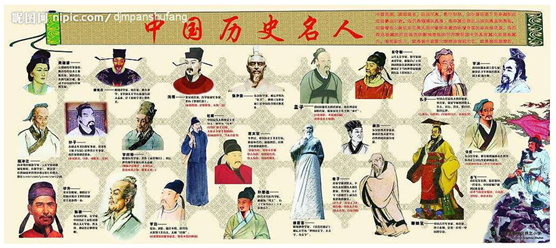
Figure 1: Illustration of Chinese historical celebrities (Network picture).
Historians have multiple explanations for the cause of the decline of the ancient Roman Empire. Through the analysis of 40 skeletal bones, American scientists found that during the Roman Empire, the rich had obvious lead poisoning. Some American pharmacists believe that lead poisoning affected the civilization, progress, and talents of the Roman Empire, and eventually led to the decline and demise of the Empire [2]. In 1983, Jerome Nriagu calculated the daily lead intake of the Romans: 250 micrograms for nobles, 35 micrograms for civilians, and 15 micrograms for slaves [3].
In the 1970s, scientists recognized that childhood lead poisoning was a global public health problem [4, 5]. In Shanghai, 128 children, total IQ, operational IQ, and language IQ, the high lead group was significantly lower than the low lead group [6]. Early lead exposure in infants is one of the determinants of later mental development. There is a dose-response relationship between blood lead and children's behavioral abnormalities [7]. Historical celebrities refer to political figures, peasant uprising leaders, literary artists, thinkers, scholars, scientific inventors, etc., who once played an important role in history and still play a great role today [8-10]. Using the paradigm analysis method of psychological history,
Understanding the nation as a whole. The influence of important people may make history choose a certain direction. After choosing this general direction, The personal factors of important people also make certain details of history change personally. Studying the psychological characteristics of these individuals is of great significance [11].
2. Method and Technology
The factors of human health and longevity include society, environment and individual. Human beings live in a certain natural environment, and their health status and longevity are inevitably affected by various natural factors. How does the geographical environment affect the human life and the spiritual condition, is still a weak link [12]. To this end, the author extensively collected the geographical coordinates of the birthplaces of Chinese historical celebrities (Figure 1), the classification of social and historical functions, and the current natural geographical conditions, socioeconomic factors, and soil geochemical indicators, Use correlation analysis, this paper has discussed the relationship between the geological ecological environment and the spatial distribution and social functions of Chinese historical celebrities.
3. Physical Geography and Socio-Economic Constraints on the Spatial Distribution of all Historical Celebrities
Population distribution is the spatial expression of population process, and population density is the main index to measure population distribution. The most remarkable feature of China's population is that the population distribution in the southeast half is highly dense, while the population distribution in the northwest half is extremely sparse; The second characteristic is that the population is obviously concentrated in the coastal areas; The closer to the inland, the more sparse the population; The third feature is the lowland directive property in the vertical direction of population. Factors influencing population distribution include natural factors (climate, terrain, soil, water, mineral resources), social factors (mode of production and productivity level, level of economic development, mode of economic activity), historical and political factors [1]. China is famous for the continuity of its history, and the spatial and temporal distribution of the number of provinces of all its famous historical figures has remarkable characteristics.
Time distribution characteristics of historical celebrities: Population/time density distribution, evolving with time, presents a stage increase, among them, BC2066-BC221 increased linearly between 0.04-0.45 people/year, BC221-AD1840 fluctuated between 0.57 - 2.51 people/year, and ADd1841-AD1927 jumped between 6.5-19.6 people/year (Figure 2).

Figure 2: Time distribution curve of Chinese historical celebrities.
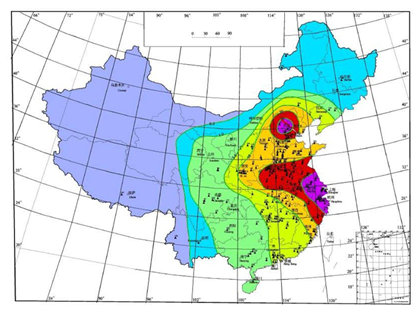
Figure 3: Distribution map of China's historical celebrity density and important historical celebrities birthplace.
The lines are contour lines of celebrity density distribution, and the black triangle is the birthplace of important historical celebrities.
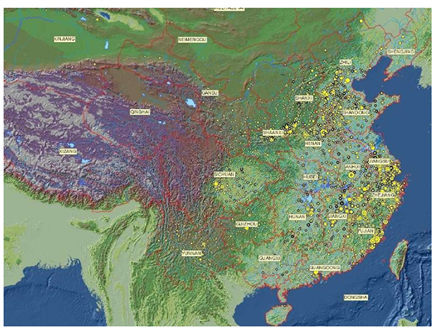
Figure 4: Geographical distribution of 67,000 historical figures of known origin in CBDB (Harvard University, 2018).
Spatial distribution characteristics of historical celebrities: The highest number was 73.2 in Beijing and 42.6 in Shanghai, gradually decreasing to the west, south and north. Beijing, Nanjing - Hangzhou line 30, Jinan - Zhengzhou - Hefei - Wenzhou line 20, Jinzhou -Taiyuan - Xi 'an - Wuhan - Nanchang - Fuzhou line 10, Shenyang - Hohhot - Yinchuan - Lanzhou - Chongqing - Changsha - Guangzhou line 5, other areas 5-0.5 (people/104 km2) (Figures 3, 4 and 6).
The results of statistical analysis show that, there is a significant correlation between the density distri-bution of historical celebrities by provincial land area and a number of physical geography, social economy and soil geochemistry indexes (Figure 5).
Physical geography conditions: Iodine Content in Drinking Water DWIC0.3691, in 2012 PM2.5 0.3225, Annual Mean Temperature AMT0.2683, Rivers water Mineralization RWM 0.2287, Annual Mean Precipitation AMP 0.1171, Rivers water Hardness RWHD-0.1818, Altitude Height -0.2538.
Social economic factor: Per capita Annual income(2011) ANIC0.8015, Population Density (2010 )
PPD0.7485, Average Life-span ALS 0.3590.
Soil geochemical indicators: K2O0.1656, MgO0.1065, Se-0.1767, V-0.1817, U-0.1839, Total sulfur S-0.1869, Cd -0.1976, Mn-0.2131, Na2O-0.2142, Organic carbon OrgC-0.2658, As-0.3313(According to the China geological survey bureau 2014, the geochemical map of China).
Influential factors of celebrity density taking cultivated land area as unit: Mo0.2827, CaO0.1707, Sr0.1556, Mg0.1503, K2O0.1322, Ti-0.1639, Co-0.1879, Se-0.1959, As-0.2058, V-0.2078, Mn-0.2162, Na2O-0.2445.
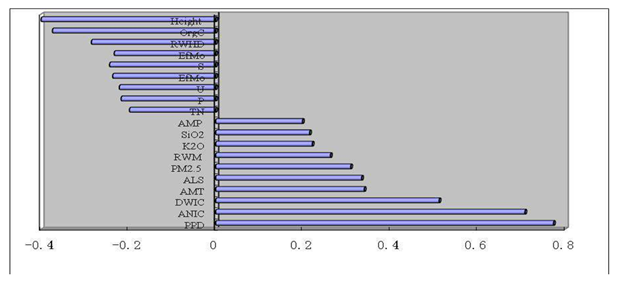
Figure 5: Correlation coefficient diagram of Chinese historical celebrity density and influencing factors.
We can establish the relevant equation between them:
lgy1 = -0.1195lgx15 - 0.2359lgx14 + 0.4277lgx13 + 0.5183x12 + 0.1592lgx1 + 0.9452, R2 = 0.4649
lgy1 = -12.793x23 + 6.8068x22 + 1.8163x2 + 0.1066, R2 = 0.2523
y2 = 5.3338lgx33 - 24.702lgx32 + 36.167lgx3 - 16.361 , R2 = 0.8158
Where y1 is the historical celebrity density in terms of land area -number of people/104km2,y2 is the density of historical celebrities in terms of cultivated land area- number of people /104hm2.
X1=( Iodine content in drinking water × Average annual temperature)/( Elevation height × River water hardness, X2=(K2O×MgO)/ (As×OrC), X3=(Mo×CaO) / (Na2O×Mn).
Population migration is a reaction of people to a series of economic, social and political factors in a particular environment. The mechanisms to explain population migration include the stimulus factors caused by environmental changes and the factors caused by personal motivation changes [1].
Xia, Shang and Zhou dynasties BC2200-BC256 and Qin and Han dynasties BC221-Ad220: Taking Henan 62-76 as the center, to Shaanxi 58-54, Shanxi 42-9, Shandong 53-39, Hebei 28-22, Hubei 22-14 and Jiangsu 1-30, decreases successively, showing an approximate circular distribution.
Three kingdoms - southern and northern dynasties 220-581: Taking Henan 78 as the center, to 46 in Shandong, 35 in Jiangsu, 34 in Hebei, 34 in Shanxi, 23 in Gansu, 19 in Shaanxi, 18 in Anhui, 17 in Inner Mongolia and 15 in Sichuan, gradually decreases , presenting an ellipse extending in two directions of northwest and northeast.
Sui, Tang, Five dynasties, Song dynasty581-1279: The overall number has increased significantly, nearly doubling. With Henan province130 as the center, to Shaanxi 119, Shanxi 82, Hebei 80, Shandong 65, Xinjiang 37, Gansu 23, Sichuan 28, successively decreasing, at the same time, it forms the 78th subcenter of Zhejiang province, the distribution pattern shows a NW - SE zonal pattern.
Liao, Xia, Jin and Yuan dynasties 907-1368: Centering on 89 members of Inner Mongolia grassland, it was ranked 37 in Hebei, 25 in Heilongjiang, 19 in Zhejiang, 14 in Henan and 14 in Beijing, decreasing successively, presents a northeast-southwest zonal distribution, reflecting the emergence of northern nomads on the historical stage, forming a situation of separation and confrontation between the north and the south.
During the Ming dynasty 1368-1644: Centered in Jiangsu 71, to Anhui 66, Zhejiang 57, Jiangxi 36, Shaanxi 34, Henan 27, Hubei 21, Sichuan 15, Shanxi 14, Guangdong 13 and Fujian 13, in descending order, reflects the rise and revival of the Han nationality in the southeast coast.
In the Qing dynasty 1616-1911: The overall number is unprecedented, Beijing 93, Liaoning 62, Jiangsu 87, Fujian 64, Hunan 57, Guangdong 56 as the center, rapidly declines to below 10 to the west and north, forming a polycentric ring distribution towards the east coast, reflects the sharp conflict of multi-culture.
In the early of the republic of China 1912-1927: Centered on the southeast coast of Zhejiang 38, Guangdong 38 and Hubei 35, rapidly declines to below 5 to the northwest, reflects the leading role of important historical figures (Sun yat-sen and Chiang kai-shek) and important historical events (the revolution of 1911). The time-space evolution of historical celebrity density is a true reflection and faithful record of the evolution of natural environment and human survival ability in the Chinese mainland in the past 4,000 years.
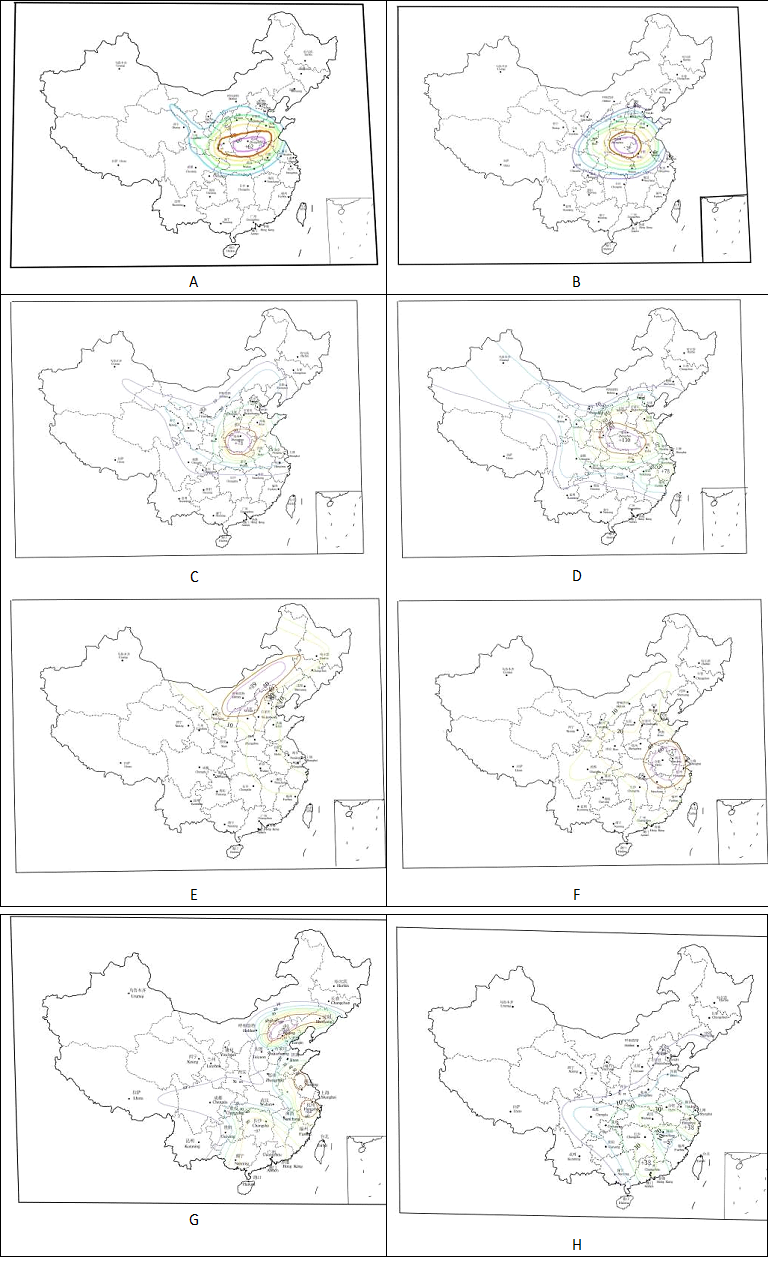
Figure 6: The temporal evolution diagram of the quantity of Chinese historical celebrities in different provinces.
A-Xia-Shang-Zhou dynasties, B-Qin and Han dynasties, C-Three Kingdoms and the Northern and Southern dynasties, D- Sui, Tang, Five dynasties and Song dynasty, E- Liao Jin-Yuan Xia, F- Ming dynasty, G-Qing dynasty, H-In the early of the republic of China
4. The Relationship Between Social Function and Ecological Environment of Important Historical Celebrities
China has a long history, the development of history cannot be separated from human beings, it is mankind that makes history. Chinese all previous dynasties attached great importance to recording history, and the biography centered on characters became the main form of historical records compiled and revised by the dynasties' historians.
These documents record the historical figures handed down from one dynasty to another. Through its story, biography, life experience and other aspects of the performance of different historical color.
Following the principle of playing an important leading role in major historical events, 248 important historical celebrities were selected from all historical celebrities. In terms of their social function and their professional field, the author divides these important historical celebrities into: Aa-UTCO- Maintain type thought and cultural celebrities, Ab-CPMP-Constructive political and military celebrities, Ba-CTCP Critical type thought and cultural celebrities, Bb-DPMP- Destructive political and military celebrities.
In terms of geological and ecological environment, there are obvious differences between the places of birth of the two types of celebrities.
Age distribution ratio of strata and rock mass The latter quaternary Q, cretaceous K, Jurassic J, devonian D, Sinian Z decreased significantly.
Rock type distribution ratio: The latter sandstone, siltstone, mudstone and loess decreased obviously. Clay rock, shale, peat coal seam, basalt, andesite, rhyolite, marl, granite and so on increase obviously.
Soil type distribution ratio: The latter has a signify-cant decrease in fluvo-aquic soil, cinnamon soil and bauxite, paddy soil, red soil, latosolic red soil and yellow soil increased significantly.
Ecological types: The latter farmland decrease significantly, forest increases apparently.
Soil life element content: The latter Ca, Na, Sr element content decreased obviously, Si, Al, K/Na, Ti, V, Zn, Cu, Mo, U, Pb, Hg, Cd element content increased obviously.
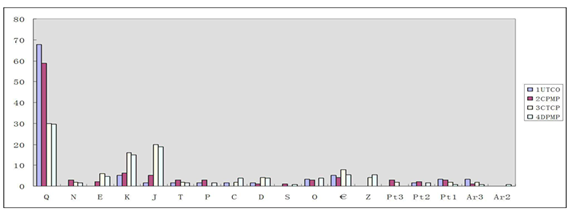
Distribution of stratum and rock mass geological ages in the birthplaces of China important historical celebrities.

Distribution of rock types in the birthplaces of China important historical celebrities.

Distribution of soil types in the birthplaces of China important historical celebrities.
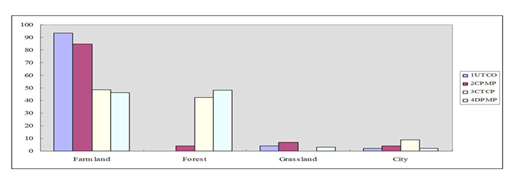
Distribution of ecological types in the birthplaces of China important historical celebrities.

Contrast of certain life elements in the soil of the birthplace of China important historical celebrities (standardization).
5. The Theoretical Significance of Statistical Results
Modern human geography and human ecology believe that, as an important part of civilization, human production and life are inseparable from the appropriate material basis. The traditional agriculture that appeared 10,000 years ago and the modern industry that began two hundred years ago have greatly improved human viability and are a major event in the history of civilization. Fertile soil, clean water, and rich mineral deposits are necessary for industry and agriculture. This means that human civilization will be subject to geological and geochemical conditions [13].
Soil geochemical characteristics not only restricts agricultural and forestry production, disease health, but also concerns the existence of historical and cultural celebrities and their social function types. In the process of growth and development, Animals and plants actively or passively ingest a certain proportion and form of chemical elements from the outside. Those elements essential for life to occur and maintain normal growth and development are called essential elements of life, such as C, H, O, N, P, S, Ca, Mg, Fe, Mn, K, Na, Cl, Zn, Cu , Mo, Se, I, Co, etc.;Those elements that can cause individual developmental disorders and even life-threatening are called life harmful elements . These are divided into completely harmful and unhelpful elements such as Pb, As, Hg, Cd, Cr6+, etc, and excessive or inappropriate forms of harmful elements such as F, Cl, I, Cu, Zn, N, Mo, Se, and the like.
Soil is the beginning of the biological cycle of elements and the most stable home to return. The geochemical distribution of elements in the soil layer and its biological chain relationships are critical to the impact of the human ecological environment. An element that is actively or passively absorbed by a living body in different forms ,it becomes an integral part of the organism. Due to the difference in the types and contents of the elements, it is bound to affect the structure, physiological functions and even psychological functions of the organism. The spatial distribution pattern of biomes with different functions will lead to different eco-environmental effects.
Lead is a non-degradable environmental pollutant. It can accumulate for a long time. It can enter the human body through the food chain - soil and air, involving the nervous system, causing paralysis of the limbs, permanent brain damage, and has damage to hematopoietic, digestive, cardiovascular and cerebrovascular systems. It is toxic to various tissues of the human body [14]. Ren Xiujuan et al. (2012) tested the soil barreling of farmland in the Chenzhou mining area of Hunan Province, in the treatment of soil lead pollution, with the increase of soil lead content, the lead content of maize roots, stems, cobs and grains showed a significant increase trend. The distribution of lead in various organs of corn is root > stem > cob > grain [15].
Gao Qi et al. (2010), the rice roots, stems, grains and stems have a certain enrichment of lead in soil [16]. Wang Lin (2005), using soil and water test methods, studied the absorption and accumulation characteristics of cadmium and lead in vegetables and toxic physiological response, the results showed that there was a significant positive correlation between the content of cadmium and lead in rapeseed and radish and the content of added heavy metals in soil [17]. Zhao Yong et al. (2008) studied that with the increase of Pb concentration in soil, the Pb content in five leafy vegetables in Zhengzhou showed an increasing trend, and positive correlation with Pb content in soil [18]. Deng Lujun et al. (2013) Potted plant experiment results showed that there was a linear and significant positive correlation between lead treatment at different concentrations in soil and lead content and accumulation in potato tubers [19]. Wang Qiuli (2007) Shenyang urban test results, under the stress of soil lead pollution, within 24 hours, as time increases, the lipid peroxidation of alfalfa increases, the content of malondialdehyde increases, and the stability of the lysosomal membrane changes, and there is a certain dose-effect relationship with the lead content of the tissue [20].
In recent years, due to environmental pollution, children in some areas have high blood lead levels, which has become a hot spot for pediatricians and online consultation. Lead pollution is becoming a serious public health issue related to national security. There is a significant positive correlation between the data on the blood lead exceeding rate in children in different regions of China and the data on lead, zinc and calcium in the stream sediments of the corresponding sites.
Content unit:Pb Znμg/g, Ca%, source: China Geological Survey Bureau 2015 People's Republic of China Geochemistry Atlas
Excess rate of blood lead in Chinese children (%) and lead, zinc and calcium in stream sediments.
Through regression analysis, we can establish the following linear equation between children's blood lead exceeding rate (y) and stream sediment lead content:
y = 19.039Ln(x) - 27.219 R2 = 0.7348 n=18,γ=0.7027,γ0.05=0.4438
Between the children's blood lead exceeding rate (y) and the water sediment calcium content CaO%, we can establish the following linear equation:
y = 1.1179x2 - 14.681x + 70.937 R2 = 0.5636 n=18,γ=-0.73199,γ0.05=0.4438
Tang Qing et al (2003), students who regularly reside in industrial development zones have significantly higher levels of lead in their hair than suburban students. High levels of lead in people who like high-lead foods (>> 20η g/g, normal range 2.95-16.58η g/g, average 15.52η g/g), they showed poor learning, memory loss, inattention, short stature, pale and weak, poor exercise tolerance, poor visual and auditory susceptibility, susceptibility to colds, low immunity and other symptoms [21].
Shi Tiantian et al (2003), 311 children aged 7-10 years in Jinzhou City, Children's IQ value was significantly negatively correlated with lead content in hair, and was significantly positively correlated with zinc and copper content in hair [22]. Cadmium is the strongest biologically toxic heavy metal element. It has strong chemical activity, high mobility and long-lasting toxicity in the environment. It is easy to endanger human health through the enrichment of the food chain. It has pathogenic, carcinogenic and mutagenic effects on the human body, and can induce diseases such as kidney decay, arthritis and cancer [23]. Soluble cadmium in the soil enters the human body through the food chain, causing damage to tissues and organs through long-term accumulation, and obvious lesions in the kidney, liver, lung, bone, reproductive system, cardiovascular system, gastrointestinal system, and pancreatic system. Cadmium pollution has a significant impact on female reproductive health [24].
Mercury pollution has the characteristics of persistence, migration, high bioaccumulation, strong toxicity, and any form of mercury in the environment can be converted into highly toxic methylmercury under certain conditions, with mutagenicity and teratogenicity and carcinogenic effects. Methyl-mercury is easily transferred from the mother to the fetus through the placenta. When mercury enters a pregnant woman, it can damage the central nervous system of the fetus, resulting in low cognitive ability in children. Mercury has long-range and trans-boundary pollution properties and has been listed as a global pollutant by the United Nations Environment Programme [25]. A new evidence paper has highlighted the astonishing rates of child development from conception to the end of age two and the benefit of a holistic approach to children’s health. The First Thousand Days has shown children are affected in multiple ways including through biology their experiences environment and diet their parent’s health and lifestyle during pregnancy and the broader community [26].
In short, natural geography, geological background, soil type, ecological environment, geochemistry and other factors not only restrict agricultural production, human health, but also affect the historical celebrity density distribution and the social function types of important historical celebrities. This is a new field of cultural geography and psychogeology research.
References
- WANG enyong, ZHAO rong, ZHANG Xiaolin, et al. Hman geography-textbook Series for 21st century. Beijing: Higher education Press 38 (2000): 50-67.
- Gilfillan SC. Lead Poisoning and the fall of Rome. J.Occup Med 7 (1965): 53-60.
- Nriagu JO. Satumin gout among Roman aristocrats . Did Lead poisoning contribate to the fall of the empire [J]. New Engl J Med 308 (1983): 660-663.
- Pocock S, Smith M, Baghurst P. Environmental Lead Children’s intelligence: A systematic review of the epidemiologic evidence [J]. Brit Med J 309 (1994): 1189-1197.
- Pirkle JL, Brody DJ, Gunta EW, et al. The decline in blood lead levels in the United States. The national health and nutrition examination surverys [J]. JAMA 2272 (1994): 284-291.
- Effects of Lead on Chilren’s Development and Its prevention: a10-yeay program of cross studies –sectional and longitadinal [J]. Guangdong Trace Element Science 8 (2001): 1-5.
- IONG Yu-hui, YANG Xiao-e, PAN Li. Effect of Environmental Lead Exposure on the Intelligence and Behavior of Children [J]. Guangdong Trace Element Science 11 (2004): 1-5.
- QIU Shusen. Ancient China famous dictionary [M] . Nanchang: Jiangxi Education Press (1986): 4-626.
- HU Kaiwei. 100 historical celebrities who influenced Chinese history [M]. Beijing: Foreign Languages Press (2012): 1-227.
- Harvard University, Academia Sinica, and Peking University. China Biographical Database (2018).
- ZHU Jianjun. Interpretation of the Personalities of Chinese Historical Celebrities [M]. Beijing :Beijing Normal University Press (2015): 1-236.
- FANG Rukang, DAI Jiaqing. Chinese Medical Geography [M]. Shanghai: East China Normal University Press (1993): 183-184.
- Wells HG. The outline of History-A Plain History of Life and Mankind Doubled and Company [M] Inc. New York (1971): 33-63.
- WEI Cuiying. Lead Pollution and Human Health [J] Biology Bulletin 34 (1999): 24.
- REN Xiujuan Zhu Donghai Wu Haiqing, et al. Effects of soil lead pollution on dry matter yield and lead uptake of maize [J], Journal of Henan University of Science and Technology 40 (2012): 12-14.
- GAO Qi, DOU Xianmin. Determination and Correlation of Total Lead Content in Soil Rice System [J], Agricultural Science and Technology Communication 38 (2010): 57-58.
- WANG Lin. Absorption and accumulation characteristics and physiological responses of cadmium and lead in vegetables [D], Shandong Agricultural University Master Thesis (2005): 1-2.
- ZHAO Yong, LI Hongjuan, WEITingting, et al. Correlation analysis of lead pollution in soil vegetables and threshold value of soil lead pollution [J], Chinese Journal of Eco-Agriculture 4 (2008): 843-847.
- DENG Lu-Jun, Xia Jinhui, Zhang Yuli, et al. Effects of Lead pollution in soil on Nitrogen Phosphorus Potassium and Lead Content of Potato [J] Journal of Mountain Agriculture and Biology 32 (2013): 322-325.
- WANG Qiuli. Study on Soil Lead Pollution by Using Biomarkers [D], Nankai University Master's thesis (2007): 1-2.
- TANG Qing HE Jun Han Lijuan. Relationship between the students’ Health and the Lead Content of Hair Urban environment and Urban ecology [J] 16 (2003): 54-55.
- SHI Litian, TANG Xuangle. Relationship between children's IQ and calcium, zinc, iron and lead in hair [J], Journal of Environment and Health 20 (2003): 89-90.
- RAN Lie, LI Hui-he. Progress in the research of present situation of soil cadmium pollution and its hazards [J], Journal of Chongqing University of Arts and Sciences (Natural Science Edition) 30 (2011): 69-73.
- LIU Xu, FAN Zhongxue, ZHANG Bin, et al.Cadmium pollution of soil and its remediation in China[J], Shandong Agricultural Sciences 6 (2007): 94-97.
- XUYan CHEN Yong-qing. Present situation of mercury pollution in the environment and its health hazardsin China [J], Occup and Health 28 (2012): 879-881.
- Tim Moore. Head start is best for first 1000 days (2017).
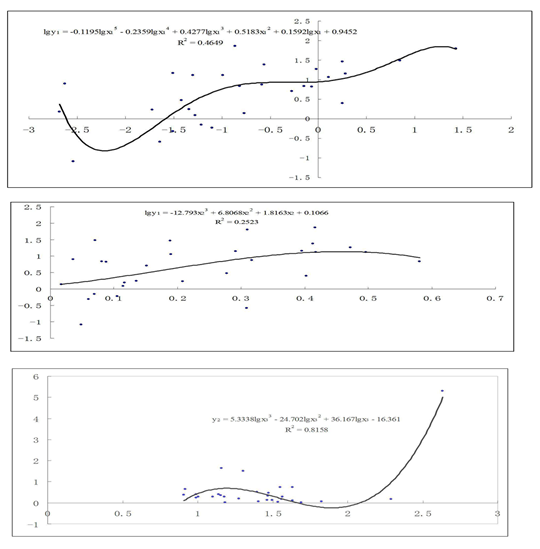
Scatter plot of Chinese historical celebrities by province density y-related factors x.
Age distribution Proportion% of strata in the birthplace of important historical celebrities in China.
1Aa-UTCO- Uphold thinking and cultural celebrities, 2Ab-CPMP- Constructive political and military celebrities, 3Ba-CTCP Critical thinking and cultural celebrities, 4Bb-DPMP- Destructive political and military celebrities.
Rock type distribution proportion% in the strata of the important historical celebrities in China.
Conglomerate-Cg, Quartzite-Qu, sandstone-Ss, Siltstone-St, Mudstone-Ms, Clay rock-Cr, shale-Sh, Dolomites-Dol, Marl-Ml, Limestone-Ls, Peat coal seam-coal, Siliceous rock-Si, Iron rock-Fe, Manganese ore-Mn, Phosphorite-Pho, Rock salt-Sa, Basalt-β, Andesite-α, trachyte-τ, Rhyolite-λ, Tuff-T, Diorite-δ, syenite-ζ, granite-γ, Gneiss-Gn, Granulite-Gr, leptite-lep, amphibolite-am, marble-Mb, phyllite-Ph, Schist-Sch, Slate-Sl, magnetite-Mt.
Soil type distribution% in birthplaces of important historical celebrities in China.
3 Dark brown earths, 5 Brown earths, 6 Yellow brown earths, 7 Drab soils, 9 Lou soil, 10 Yellow earths, 11 Red earths, 12 lateritic red earths, 13 Latosoil, 17 Chao soil, 15 Black soils, 21 Chestnut soil, 29 Purplish soil, 30 Mein soil, 31 Aeolian sandy soil, 32 Solonchak, 34 Paddy soil, 37 Sub-alpine steppe soil.
|
Category |
Farm land |
Forest |
Grassland |
City |
|
1 |
93.62 |
0.00 |
4.26 |
2.13 |
|
2 |
84.72 |
4.23 |
6.94 |
4.17 |
|
3 |
48.48 |
42.42 |
0.00 |
9.09 |
|
4 |
46.36 |
48.42 |
3.16 |
2.11 |
Ecological types% in the birthplaces of important historical celebrities in China.
Soil life element content in the birthplace of important historical celebrities in China.
